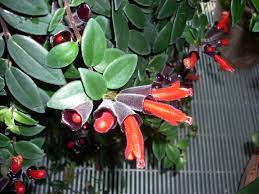'Lipstick' plant rediscovered in Arunachal after 100 years

- Country:
- India
Researchers at the Botanical Survey of India (BSI) have rediscovered a rare plant, which is sometimes called the ‘Indian lipstick plant’, from remote Anjaw district in Arunachal Pradesh after more than a century.
The plant (Aeschynanthus monetaria Dunn) was first identified by British botanist Stephen Troyte Dunn in 1912, based on the plant samples gathered from Arunachal Pradesh by another English botanist, Isaac Henry Burkill.
“Due to the appearance of the tubular red corolla, some of the species under the genus Aeschynanthus are called lipstick plants,” BSI scientist Krishna Chowlu said in an article on the discovery published in Current Science journal.
During floristic studies in Arunachal Pradesh, Chowlu collected a few specimens of Aeschynanthus from Hyuliang and Chipru of Anjaw district in December 2021.
A review of the relevant documents as well as a critical study of the fresh specimens confirmed that the specimens were Aeschynanthus monetaria, which had never been obtained from India since Burkill in 1912.
As per the article co-authored by Gopal Krishna, the genus name Aeschynanthus is derived from the Greek Biscayne or aischyn, which means shame or to feel embarrassed respectively, and anthos, which means flower. Aeschynanthus monetaria Dunn is morphologically unique and distinct among all the Aeschynanthus species known from India by its fleshy orbicular leaves with a greenish upper surface and purplish-green lower surface. The specific epithet 'monetary' means ‘mint-like’, alluding to the appearance of its leaves.
The plant grows in moist and evergreen forests, at elevations ranging from 543 to 1134 m. The flowering and fruiting time is between October and January.
The species has been provisionally assessed here as ‘endangered’, following the guidelines of the International Union for Conservation of Nature (IUCN), the global authority on the status of the natural world and the measures needed to safeguard it.
“Landslides are frequent in the Anjaw district of Arunachal Pradesh. Developmental activities such as broadening of roads, construction of schools, new settlements and markets, and jhum cultivation are some of the major threats to this species in Arunachal Pradesh,” Chow said in the abstract of the Current Science report.
There have been lots of rediscoveries of various species in Arunachal which speaks of the rich biodiversity of the state, but experts say that more dedicated explorations are needed to unravel more, according to Chow.
(This story has not been edited by Devdiscourse staff and is auto-generated from a syndicated feed.)
ALSO READ
Global Tensions Trigger Downturn in Indian Stock Markets
Indian-American Community Embraces Trump's Historic Presidential Win
Foreign Outflows Impact Indian Market Amid Robust Economic Growth
Bangladeshi Nationals Detained at Indian Railway Station Amidst Cross-Border Trespass Investigation
Tragedy on the Indian Ocean: Human Smuggling Ring Exposed










